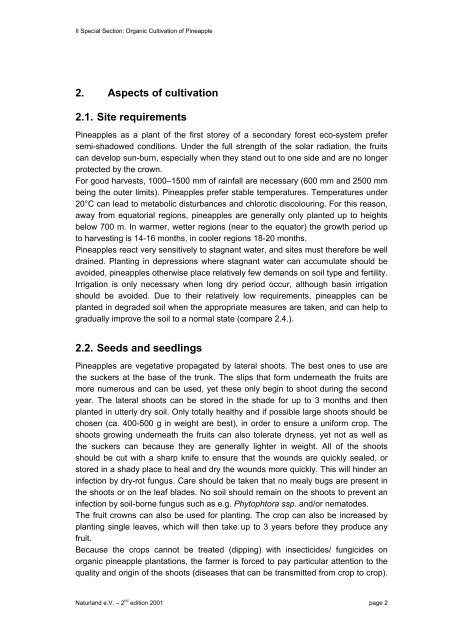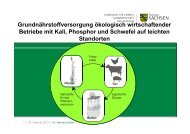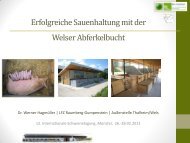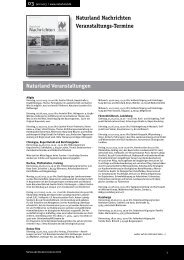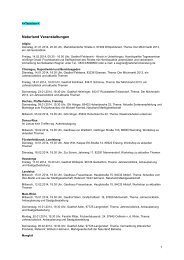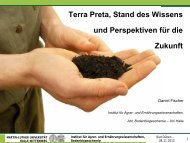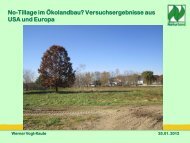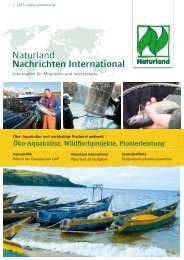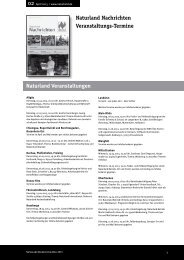Organic Farming in the Tropics and Subtropics: Pineapple - Naturland
Organic Farming in the Tropics and Subtropics: Pineapple - Naturland
Organic Farming in the Tropics and Subtropics: Pineapple - Naturland
Create successful ePaper yourself
Turn your PDF publications into a flip-book with our unique Google optimized e-Paper software.
II Special Section: <strong>Organic</strong> Cultivation of P<strong>in</strong>eapple<br />
2. Aspects of cultivation<br />
2.1. Site requirements<br />
P<strong>in</strong>eapples as a plant of <strong>the</strong> first storey of a secondary forest eco-system prefer<br />
semi-shadowed conditions. Under <strong>the</strong> full strength of <strong>the</strong> solar radiation, <strong>the</strong> fruits<br />
can develop sun-burn, especially when <strong>the</strong>y st<strong>and</strong> out to one side <strong>and</strong> are no longer<br />
protected by <strong>the</strong> crown.<br />
For good harvests, 1000–1500 mm of ra<strong>in</strong>fall are necessary (600 mm <strong>and</strong> 2500 mm<br />
be<strong>in</strong>g <strong>the</strong> outer limits). P<strong>in</strong>eapples prefer stable temperatures. Temperatures under<br />
20°C can lead to metabolic disturbances <strong>and</strong> chlorotic discolour<strong>in</strong>g. For this reason,<br />
away from equatorial regions, p<strong>in</strong>eapples are generally only planted up to heights<br />
below 700 m. In warmer, wetter regions (near to <strong>the</strong> equator) <strong>the</strong> growth period up<br />
to harvest<strong>in</strong>g is 14-16 months, <strong>in</strong> cooler regions 18-20 months.<br />
P<strong>in</strong>eapples react very sensitively to stagnant water, <strong>and</strong> sites must <strong>the</strong>refore be well<br />
dra<strong>in</strong>ed. Plant<strong>in</strong>g <strong>in</strong> depressions where stagnant water can accumulate should be<br />
avoided, p<strong>in</strong>eapples o<strong>the</strong>rwise place relatively few dem<strong>and</strong>s on soil type <strong>and</strong> fertility.<br />
Irrigation is only necessary when long dry period occur, although bas<strong>in</strong> irrigation<br />
should be avoided. Due to <strong>the</strong>ir relatively low requirements, p<strong>in</strong>eapples can be<br />
planted <strong>in</strong> degraded soil when <strong>the</strong> appropriate measures are taken, <strong>and</strong> can help to<br />
gradually improve <strong>the</strong> soil to a normal state (compare 2.4.).<br />
2.2. Seeds <strong>and</strong> seedl<strong>in</strong>gs<br />
P<strong>in</strong>eapples are vegetative propagated by lateral shoots. The best ones to use are<br />
<strong>the</strong> suckers at <strong>the</strong> base of <strong>the</strong> trunk. The slips that form underneath <strong>the</strong> fruits are<br />
more numerous <strong>and</strong> can be used, yet <strong>the</strong>se only beg<strong>in</strong> to shoot dur<strong>in</strong>g <strong>the</strong> second<br />
year. The lateral shoots can be stored <strong>in</strong> <strong>the</strong> shade for up to 3 months <strong>and</strong> <strong>the</strong>n<br />
planted <strong>in</strong> utterly dry soil. Only totally healthy <strong>and</strong> if possible large shoots should be<br />
chosen (ca. 400-500 g <strong>in</strong> weight are best), <strong>in</strong> order to ensure a uniform crop. The<br />
shoots grow<strong>in</strong>g underneath <strong>the</strong> fruits can also tolerate dryness, yet not as well as<br />
<strong>the</strong> suckers can because <strong>the</strong>y are generally lighter <strong>in</strong> weight. All of <strong>the</strong> shoots<br />
should be cut with a sharp knife to ensure that <strong>the</strong> wounds are quickly sealed, or<br />
stored <strong>in</strong> a shady place to heal <strong>and</strong> dry <strong>the</strong> wounds more quickly. This will h<strong>in</strong>der an<br />
<strong>in</strong>fection by dry-rot fungus. Care should be taken that no mealy bugs are present <strong>in</strong><br />
<strong>the</strong> shoots or on <strong>the</strong> leaf blades. No soil should rema<strong>in</strong> on <strong>the</strong> shoots to prevent an<br />
<strong>in</strong>fection by soil-borne fungus such as e.g. Phytophtora ssp. <strong>and</strong>/or nematodes.<br />
The fruit crowns can also be used for plant<strong>in</strong>g. The crop can also be <strong>in</strong>creased by<br />
plant<strong>in</strong>g s<strong>in</strong>gle leaves, which will <strong>the</strong>n take up to 3 years before <strong>the</strong>y produce any<br />
fruit.<br />
Because <strong>the</strong> crops cannot be treated (dipp<strong>in</strong>g) with <strong>in</strong>secticides/ fungicides on<br />
organic p<strong>in</strong>eapple plantations, <strong>the</strong> farmer is forced to pay particular attention to <strong>the</strong><br />
quality <strong>and</strong> orig<strong>in</strong> of <strong>the</strong> shoots (diseases that can be transmitted from crop to crop).<br />
Naturl<strong>and</strong> e.V. – 2 nd edition 2001 page 2


